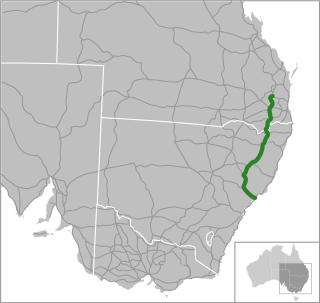
The New England Highway is an 878-kilometre (546 mi) long highway in Australia running from Hexham at Newcastle, New South Wales at its southern end to Yarraman, north of Toowoomba, Queensland at its northern end. It is part of Australia's National Highway system, and forms part of the inland route between Brisbane and Sydney.

The Hunter River is a major river in New South Wales, Australia. The Hunter River rises in the Liverpool Range and flows generally south and then east, reaching the Tasman Sea at Newcastle, the second largest city in New South Wales and a major harbour port. Its lower reaches form an open and trained mature wave dominated barrier estuary.

Singleton is a town on the banks of the Hunter River in New South Wales, Australia. Singleton is 144 km (89 mi) north-north-west of Sydney, and 70 km (43 mi) northwest of Newcastle. At June 2018, Singleton had an urban population of 16,346.

Muswellbrook is a town in the Upper Hunter Region of New South Wales, Australia, about 243 km (151 mi) north of Sydney and 127 km (79 mi) north-west of Newcastle.
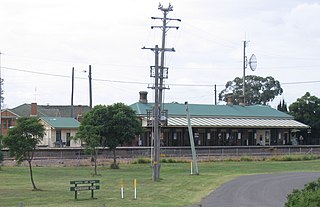
Singleton railway station is a heritage-listed railway station located on the Main Northern line in New South Wales, Australia. It serves the town of Singleton. It was added to the New South Wales State Heritage Register on 2 April 1999.

Maitland railway station is located on the Main Northern line in New South Wales, Australia. It serves the city of Maitland opening on in 1880 as West Maitland being renamed on 1 April 1949. It is the junction station for the Main Northern and North Coast lines. It was added to the New South Wales State Heritage Register on 2 April 1999.

Greta railway station is a heritage-listed railway station located on the Main Northern line in New South Wales, Australia. It serves the town of Greta opening on 24 March 1862 as Farthing being renamed in 1878. It was added to the New South Wales State Heritage Register on 2 April 1999.

Muswellbrook railway station is a heritage-listed railway station located on the Main Northern line in Muswellbrook, in the Muswellbrook Shire local government area of New South Wales, Australia. The station serves the town of Muswellbrook and was designed by John Whitton, the Chief Engineer of NSW Railways. It is also known as Muswellbrook Railway Station and yard group and Musclebrook Railway Station. The property was added to the New South Wales State Heritage Register on 2 April 1999.

Muswellbrook Shire is a local government area in the Upper Hunter region of New South Wales, Australia. The Shire is situated adjacent to the New England Highway and the Hunter railway line.
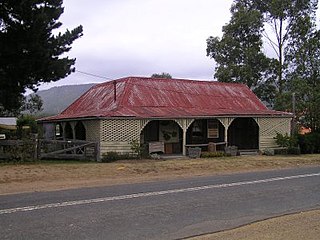
Rising Sun Inn is a heritage-listed former post office, inn, general store and residence and now museum, craft shop and art gallery at 95-97 Wollombi Road, Millfield, City of Cessnock, New South Wales, Australia. It was built from 1832 to 1838. It was added to the New South Wales State Heritage Register on 2 April 1999.
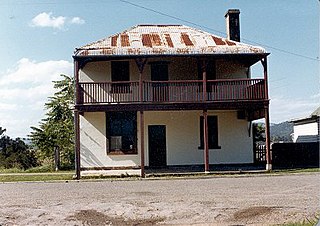
Royal Oak Arms Hotel is a heritage-listed former Australian pub, store and bank building at 18 King Street, Paterson, Dungog Shire, New South Wales, Australia. It was also known as the Royal Oak Inn. It was added to the New South Wales State Heritage Register on 2 April 1999.
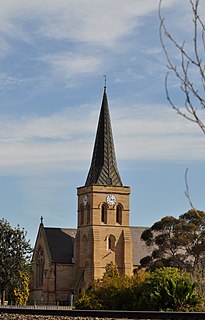
St Alban's Anglican Church is a heritage-listed Anglican church located at Hunter Terrace, Muswellbrook in the Muswellbrook Shire local government area of New South Wales, Australia. It was designed by Sir George Gilbert Scott and built from 1864 to 1869 by Edmund Blacket, supervised by John Horbury Hunt. It is also known as St. Alban's Anglican Church and St Albans Church. The property is owned by the Trustees of the Anglican Diocese of Newcastle. The church was added to the New South Wales State Heritage Register on 2 April 1999.

The Royal Oak Inn is a heritage-listed hotel located on the corner of Windsor Road and Commercial Road, in Rouse Hill in The Hills Shire local government area of New South Wales, Australia. It was built in 1829. It has also been known as the Queens Arms Inn, and is currently known as the Fiddler Hotel. The property is privately owned and was added to the New South Wales State Heritage Register on 2 April 1999.

White Horse Inn is a heritage-listed former residence, inn, bank and restaurant at Market Street, Berrima, Wingecarribee Shire, New South Wales, Australia. It was built from 1834 to 1850 by Edward Davies. It is also known as Commercial Bank of Australia, Rosebank, Oldbury's Inn, Holsberry Inn, Mail Coach Inn, and Royal Mail Coach Inn. It was added to the New South Wales State Heritage Register on 2 April 1999.

Victoria Inn is a heritage-listed former hotel and restaurant at 20-22 Jellore Street, Berrima, Wingecarribee Shire, New South Wales, Australia. It is also known as Queen Victoria Inn and Allington. It was added to the New South Wales State Heritage Register on 2 April 1999.

Mail Coach Inn is a heritage-listed former inn and residence at 24 Jellore Street, Berrima, Wingecarribee Shire, New South Wales, Australia. It was built from 1833 to 1841. It is also known as the Royal Mail Coach Inn. It traded in recent times as a now-closed bed and breakfast known as the Coach and Horses Inn; however, that name historically referred to a different Berrima hotel. It was added to the New South Wales State Heritage Register on 2 April 1999.

Fernhill is a heritage-listed former house and former inn and now unused building at Great Western Highway, Bowenfels, City of Lithgow, New South Wales, Australia. It was built from 1856 to 1859 by John Blackman. It is also known as Australia Arms Inn. The property is owned by National Trust of Australia (NSW). It was added to the New South Wales State Heritage Register on 2 April 1999.

Liddell is a locality in the Singleton Council of New South Wales, Australia. It had a population of zero as of the 2016 census.

Ewbank is a heritage-listed residence and former bank building at 88 George Street, Singleton, Singleton Council, New South Wales, Australia. It was designed by Benjamin Backhouse and built from 1883 to 1884. It was added to the New South Wales State Heritage Register on 2 April 1999.

The Millers Point Post Office is a heritage-listed former post office and office building and now residence at 12 Kent Street, Millers Point, City of Sydney, New South Wales, Australia. It was designed by NSW Government Architect's Office under Walter Liberty Vernon. It was added to the New South Wales State Heritage Register on 23 June 2000.
















